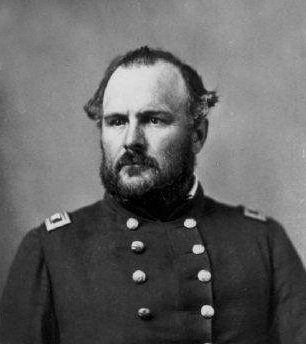You've heard the tales. You think you know the story. But really, can those stories be true? Let's see.
 |
| Cripple Creek today |
The story goes that John W. Bernard walked from Colorado Springs to Cripple Creek, a journey of about forty-five miles, and spent his first night in the mining district sleeping on the ground. When he awoke the next day he stacked out a likely looking pile of rocks and filed a claim. He named the mine for a pair of Elk Horns lying nearby. Of course, in heart of true storytelling, Mr. Bernard knew nothing about mining and supposedly gave away half of his mine to settle a grocery bill of almost forty dollars.
Now according to Mike Hurtt from his "History of the Elkton Mine" that had been accessed in 2009 from the Cripple Creek History site ( no longer available) the mine was taken over from William Shemwell and it was three Bernard brothers who purchased it.
So who has the correct story? You can decided which is true.
 |
| John Milton Chivington photo from Wikipedia |
John Milton Chivington
After the Battle of Glorietta Pass, in which Chivington 'routed' the Confederates who were attempting to relieve Colorado of its gold, he was promoted to Colonel. Quite a feat for a Methodist minister. His troups from the battle were given the name of Chivington's Pet Lambs.
His daughter was married to a much older man who traded with the Indians in Southwest Colorado. The daughters husband left her with the tribe as a guarantee he would return with their wares. He did return some six months later. The hush story is Chivington had a half-breed grandchild.
Are these stories true?
Dr. Isaac Davis
In 1874, Dr. Davis, of Manitou Springs, CO., was acquitted of manslaughter for giving his patient Mrs. Mary Ann Stringer an overdose of narcotics for gastritis. They actually exhumed the body prior to the trial.
While working as the coroner in Manitou Springs he came into the possession of the body of Tom O'Neil. Mr. O'Neil was an Irish miner who was shot in a bar fight. When no one claimed the body, Dr. Davis experimented on the body using chemical baths and sunbathing. I the end, it was said Mr. O'Neil's body looked like that of an Egyptian mummy.
Do you really think the above stories are true?
Emma Crawford
Emma was involved in Spiritualism and it was said that she played the piano with such skill, but had never taken a lesson. Instead it was claimed she acquired her skill from the spirits.
Upon her death, in 1891, Emma requested that she be buried on Red Mountain in Manitou Springs. Her wishes were honored.
In 1929 some boys were said to have found a grave and brought the skull and handles from the coffin down to Manitou Springs. It was later determined that they were of Emma Crawford. She was later buried in the local cemetery. To this day, Manitou Springs has coffin races over the Halloween weekend in honor of Emma and her opened grave on Red Mountain.
True?
I hope you enjoyed some of the tales of the Pikes Peak region. As we get ready for All Hallows Eve, what stories have you heard where you live?
In my novella "Angel of Salvation Valley" the hero makes a deal to get out of prison for a crime he did not commit. His deal, he must kill. Can he do it?
 |
| Amazon e-book |
"I'm just wondering what kind of power you have that would allow
me to get out of here, short of a prison break?"
"Nothing you need to worry about, but you can set your mind at
ease if you agree to my proposition. I'll make sure you are paroled,
after all you were drunk when you held up that stage and killed those
people."
"I didn't hold up any stage, I didn't kill anyone, so how could
I be drunk while committing the crime?" Drew interrupted.
"Never mind. Are you willing to take the job so you can get out
of here?" Luke asked, staring into Drew's eyes.
Drew felt uncomfortable with that stare. Still he hesitated. He'd
never killed anyone, unless in self defense. But if someone as evil
as this woman was needed killing, he would trade her life for his
freedom.
Breathing deeply, Drew slowly nodded his assent.
"Fine, you made a good choice," Luke said. "I'll let
you know within the next two days when you will walk out of here,"
Luke moved to knock on the cell door. "After all, it took ten
years to hunt you down," Luke whispered.
Drew moved to shake the hand Luke offered, wondering what Luke was
mumbling. Still, when Drew took the hand firmly in his own hardened
one, he was surprised at how smooth the skin was. It'd been years
since he felt something so smooth, but there was also heat and
strength behind the grip. A small fissure of pain traveled up his arm
as Luke broke off the handshake, a tightening in his scalp.
Doris Gardner-McCraw -
Author, Speaker, Historian-specializing in
Colorado and Women's History
Colorado and Women's History
Member of National League of American Pen Women,
Women Writing the West,
Pikes Peak Posse of the Westerners
Angela Raines - author: Where Love & History Meet
For a list of Angela Raines Books: Here
Photo and Poem: Click Here
Angela Raines FaceBook: Click Here




















